Grow Borage As A Fantastic Border Plant For Pollinators – Experts Share How

ANNUALS > BORAGE
Reviewed By COLIN SKELLY

Colin is a Horticulturist and Horticultural Consultant with experience in a range of practical and managerial roles across heritage, commercial and public horticulture. He holds the Royal Horticultural Society’s Master of Horticulture award and has a particular interest in horticultural ecology and naturalistic planting for habitat and climate resilience.
IN THIS GUIDE
BORAGE GUIDES
As an attractive border plant, enticer of pollinators and herb for salads and drinks, borage is a versatile and vibrant addition to any garden.
Also known as bugloss or starflower, borage is a hardy herb that’s easy to grow, great for encouraging biodiversity and attractive for its colourful blossoms.
Most varieties are annuals, meaning they’ll complete their entire life cycle within a single season, but there is a perennial version of borage that also yields good results in a backyard display.
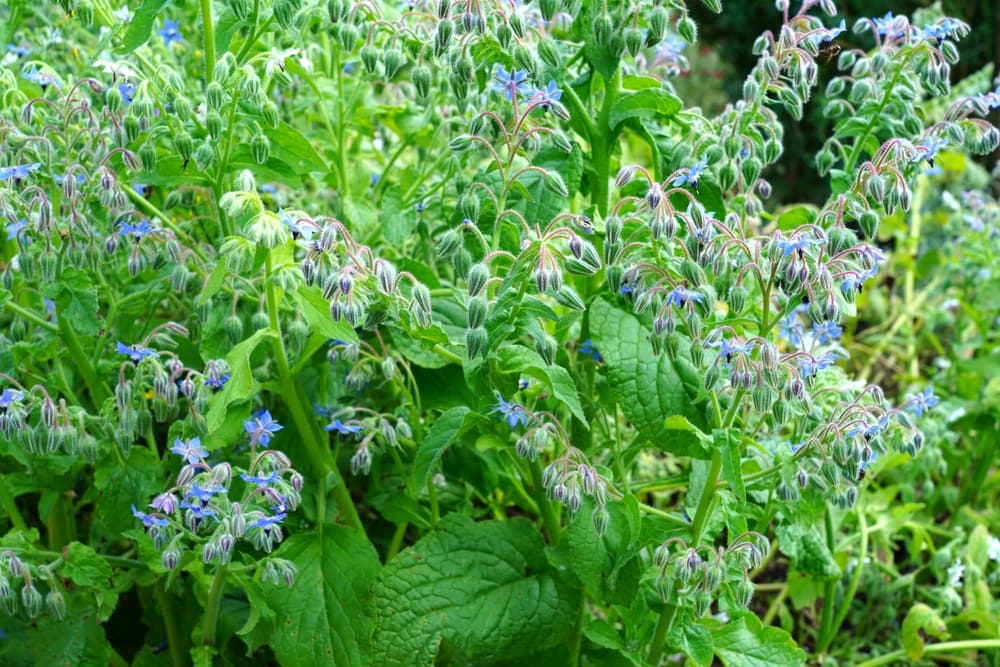
It’s a huge favourite among the bees and butterflies, making it a great choice to plant in among other herbs, fruits and veggies since it will enhance the chances of pollination.
“Borage is so popular with pollinators because it produces so many flowers that are resource-rich,” according to RHS Master of Horticulture Colin Skelly.
“These flowers supply large amounts of nectar that is re-filled rapidly when consumed and is accessible to lots of pollinators.
“You can always hear a good pollinator plant because of the hum of feeding pollinators – listen next time you’re in the garden and find out which plants in your garden pollinators are making a bee-line for!”
Although Borage is not as famous or as commonplace as other herbs like basil, mint and thyme, borage is a superb culinary condiment in its own right.
Overview
| Botanical Name | Borago officinalis |
| Common Name(s) | Borage; Starflower |
| Plant Type | Annual |
| Native Area | Mediterranean |
| Hardiness Rating | H3 |
| Foliage | Hairy leaves with long stems |
| Flowers | Blue, star-shaped flowers |
| When To Sow | March, April |
| Plant Out | May, June |
| Harvesting Months | June, July, August, September, October |
Sunlight
Preferred
Full Sun or Dappled Shade
Exposure
Exposed or Sheltered
Size
Height
0.1 – 1M
Spread
0.1 – 0.5M
Bloom Time
June – October
Soil
Preferred
Most soil types (except unamended heavy clay)
Moisture
Moist but well drained
pH
Any
All parts of the plant (excluding the roots) can be harvested and eaten, imparting a cool and refreshing flavour to food and drinks that are reminiscent of cucumber.1Borage recipes. (n.d.). BBC Food. Retrieved March 28, 2023, from https://www.bbc.co.uk/food/borage
Its blooms are most commonly used to garnish drinks or infuse teas, while its leaves can add zip and zing to salads, sandwiches, dressings and side dishes.
With so many attractive attributes, then, it’s little wonder that borage has quite an illustrious history.
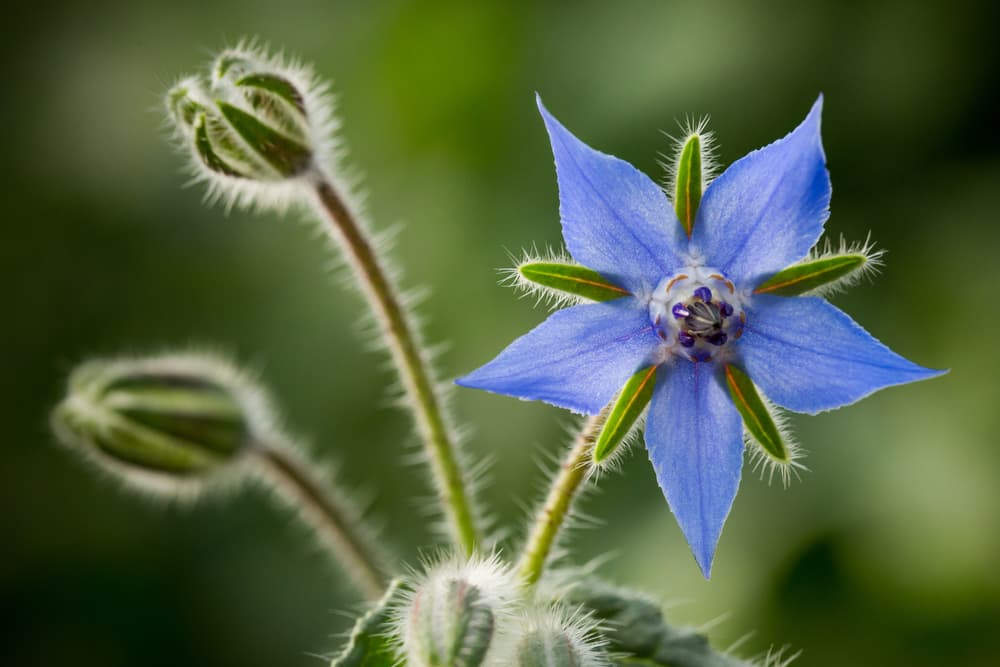
Are you won over yet? Follow these simple tips to encourage plentiful borage in your own garden.
Common Borage Varieties
Most borage varieties are annual, which means that they will die out within a single year, though many are very adept at self-seeding.
On the other hand, there are some cultivars that are perennial.
Although the flowering season of these is generally shorter, they do last for several years or more.
Here are four of the most common varieties to choose from:
B. officinalis

The most widely available borage variety, Borago officinalis is also the most popular among UK gardens.
It’s an annual capable of growing up to 60cm in size and boasts star-shaped flowers of a brilliant blue in summer.
B. officinalis ‘Variegata’
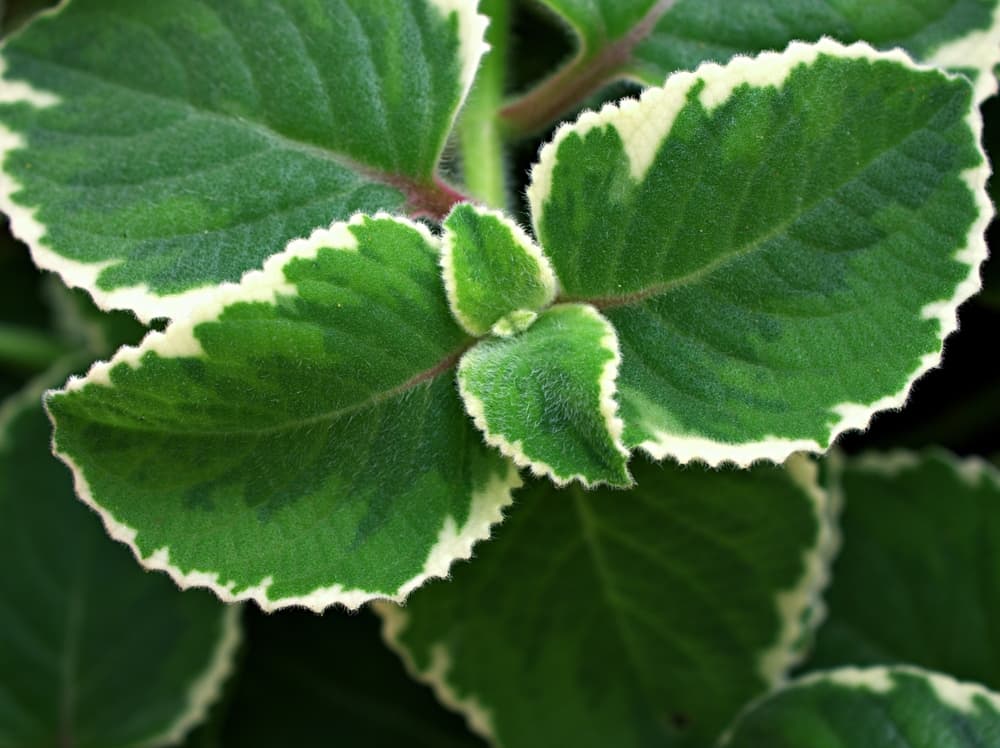
An offshoot of the common borage variety named above, this grows to a similar height and also has blue flowers, though these are of a softer hue.
Its distinctive feature is the white mottling on its leaves.
B. officinalis ‘Alba’
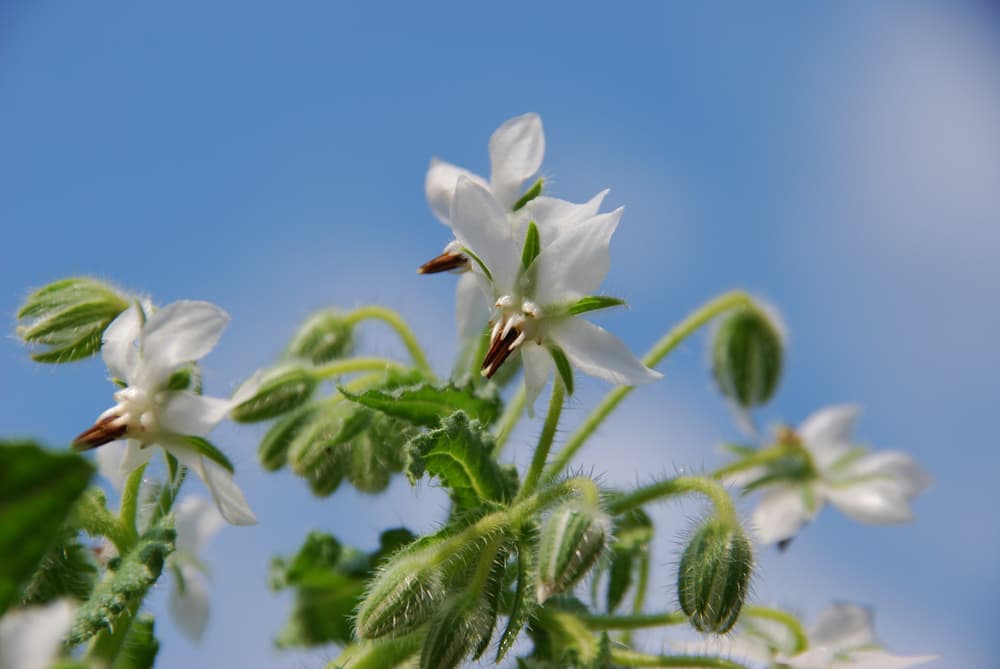
Sometimes known as white borage, this is a slightly sturdier specimen than the two mentioned above which blooms later in the year.
Its biggest difference, however, is the whiteness of its blossoms.
B. pygmae
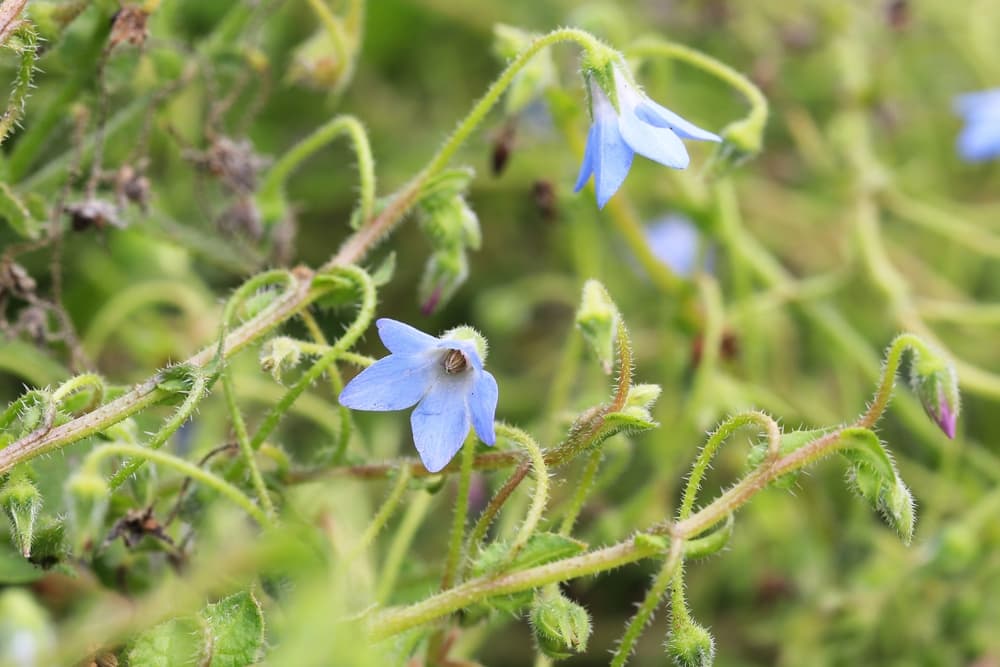
The Latin name of this perennial strain of borage indicates that it’s smaller than its annual brethren, growing to around half (30cm) their size.
It has a creeping habit and enjoys a short life, but will come back again every year.
Deciding which type of borage you prefer in your borders and backyard displays will depend primarily upon whether you’re looking for a perennial or an annual, what size plant you wish for the space available to you and whether you’d prefer blue or white blooms.
How To Grow Borage
It does insist upon exposure to the sun, however, so make sure you plant it in a spot that receives sunlight for at least half of the day.
Soil Requirements
Thankfully, borage is an unfussy plant that will grow in most soil types with little in the way of fertilisation or maintenance.
The plant absolutely hates waterlogged soil, so if your garden is particularly slow draining, you may wish to prepare the area with fine-grit or gravel.
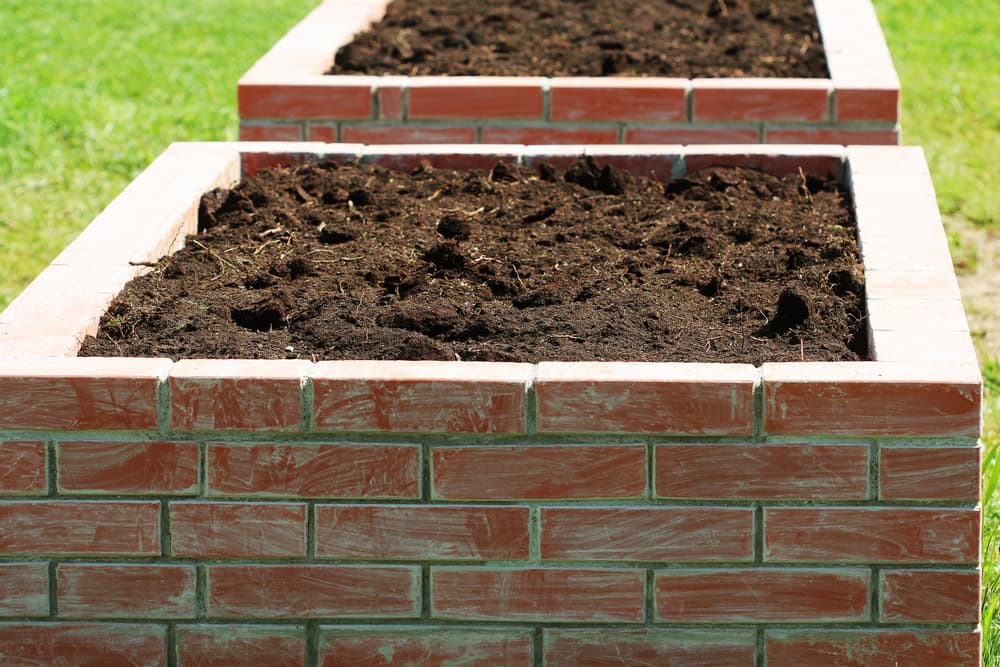
It prefers soil that isn’t particularly fertile, so there’s usually no need to add any artificial additives to its planting environment.
Mulching with organic matter is not strictly necessary, but will certainly encourage a fuller and larger plant.
Sowing
Ideally, you should seed borage exactly where you wish it to flower, since it doesn’t take too kindly to transplantation.
It can handle a potted environment if that’s preferable, though you should ensure that you select a pot large enough for its roots to grow and spread – that means at least 30cm in diameter and 25cm in depth.
The best time to sow annual borage seeds is in mid-spring (April/May), though a second sowing is possible later in the season.
Perennial borage seeds will also perform best when planted at this time, but are more forgiving if put into the ground at any other time of the year.
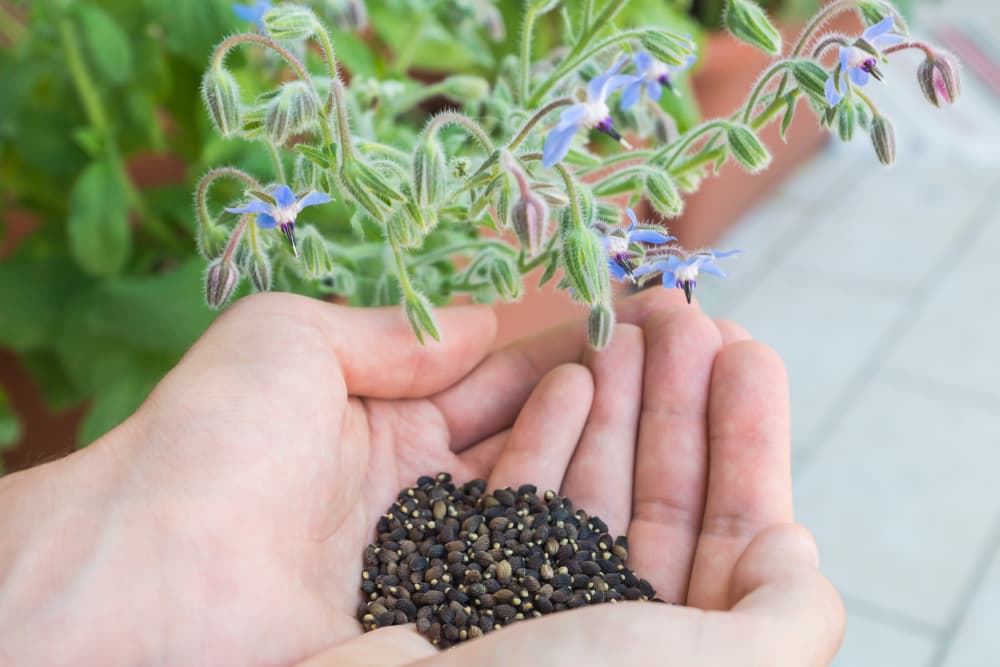
The plant is quite effective at self-seeding, so if that’s something you wish to encourage, simply leave the faded flowers on the plant.
If not, remove them as soon as they have finished blooming and collect the seeds for replanting the next year.
To plant, simply dig out a little hole 1.5cm deep and place a single seed in it, then cover over with moist soil.
Space out your rows 30cm apart and once the seedlings have begun to break through and reach a height of around 5cm, thin them out to ensure there is at least 30cm between them.

If they grow any closer together, their foliage can begin to develop symptoms of mildew, as air movement will be restricted.
Plant Care
As alluded above, borage is invariably a hardy and stress-free plant to grow – it’s even been known to thrive in rubbish dumps and at the sides of roads and highways!
Watering & Feeding
Borage is from the Mediterannean, so it copes with low rainfall but might need to be topped up with your own water in times of drought or dryness.
If growing indoors in a container, it will require frequent irrigation, which could even mean daily watering during summer.

The same goes for its feeding habits – fertilisers do not need to be used unless you’re growing it in a pot using store-bought compost.
Deadheading
As for maintenance, annuals do not require any pruning whatsoever.
Perennial varieties may demand occasional paring back during the peak of the warmer months.
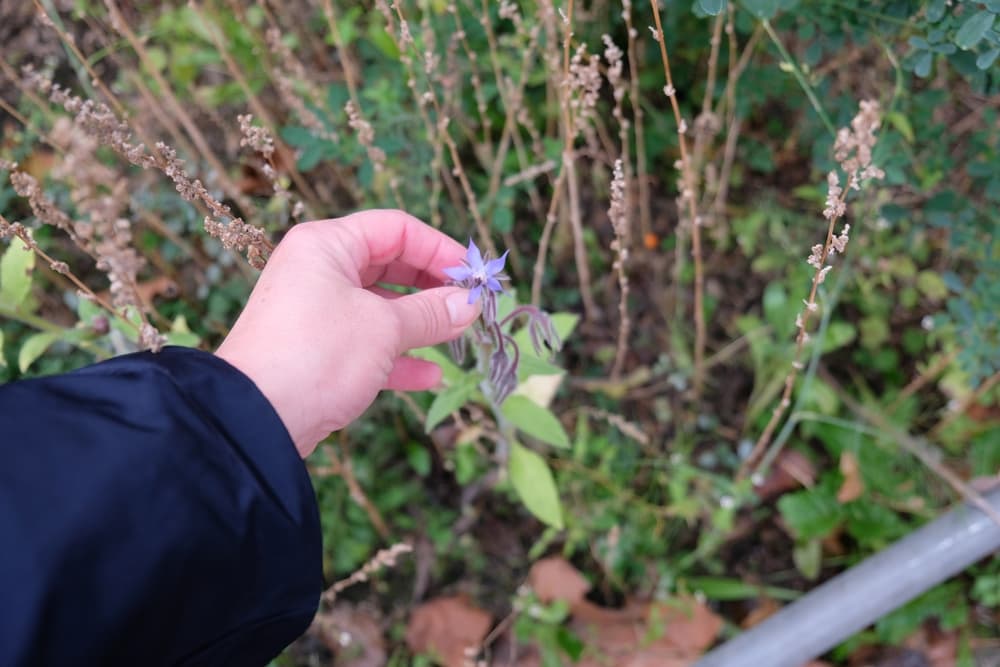
Having said that, both will benefit from stripping away faded flowerheads to encourage further growth of more flowers during summer, though it’s not strictly necessary.
Deadheading will prevent the plant going to seed so make sure this is something that you wish to prevent.
Composting
Once the flowering season of an annual has run its course, simply dig up the whole plant by its roots and use it as compost for the following season, as the nutrient-rich leaves will enhance fertilisation of the soil next time around.
If you are going to use the plant as compost, be sure to remove its seed heads first, however, or you could soon find borage popping up all over the garden!
Harvesting
The leaves and the flowers are the parts of the plant most commonly harvested for culinary purposes, both of which should be plucked in the morning after the dew has dried, but before the sun has reached its full strength and made either wilt.
The leaves lend themselves well to spicing up salads and dressings with a refreshingly cucumber-like zing.

Alternatively, you can sauté or blanch them as you would with other leafy greens like kale and spinach.
If you wish to use them as dried seasoning, simply hang them in an airy room for a day or two, or else pop them in the oven for 10 minutes.
Dried leaves also work well as a salt substitute.
They work especially well when frozen into ice cubes, which is a great way to conserve them if you have too many.
Common Problems
In general, borage is a resilient grower that won’t succumb to many pests or blights.
However, there are a handful of potential issues you should be aware of, including:
Mildew
As mentioned above, mildew is a debilitating consequence of planting borage plants too close together.
Thankfully, it’s normally solved with ease – simply space the seedlings at least 30cm apart to allow plentiful airflow beneath.
Watering it at the base of the stem rather than onto the leaves can also help.
Blackfly
Otherwise known as black bean aphids and bean leaf aphids, blackflies have been known to have their heads turned by borage foliage, too.

In itself, this isn’t strictly a problem and shouldn’t endanger the survival of the plant; in fact, it can actually be a boon by distracting the pest from bean crops.
Woolly Bear Caterpillar
These tiny creepy-crawlies are about as furry as they are unfussy and they’ll happily feast on any low-lying foliage they come across.
In practical terms, that means that encountering them on borage plants means they’ll likely be gobbling up other produce too, so control them with neem oil.
Painted Lady Butterfly
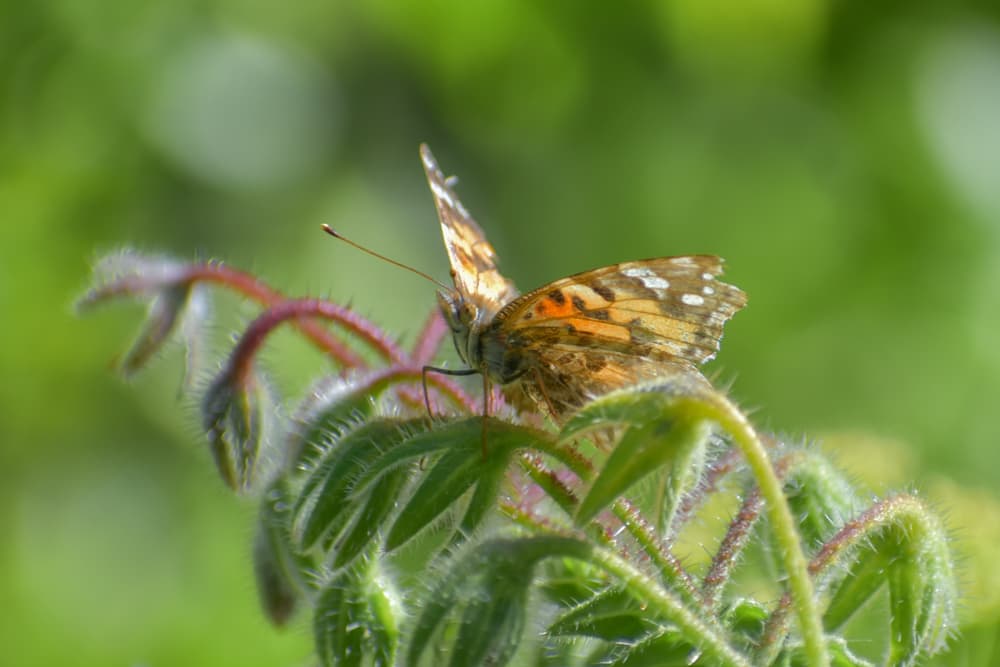
This pest causes more mild frustration than all-out desperation, usually concentrating its attacks on a single part of the plant rather than the whole thing.
Its larvae do more damage than the actual butterfly, though neither are too severe.
Deter it with sticky traps or natural insecticides.
Flea Beetle
Flea beetles come in a variety of different kinds, all of which love to gnaw through the leaves of borage plants.
Though they don’t do too much damage beyond the cosmetic in moderation, if you get an infestation, it can lead to more serious problems.
Clean up fallen leaves and other debris to remove their habitat in late autumn.
References
- 1Borage recipes. (n.d.). BBC Food. Retrieved March 28, 2023, from https://www.bbc.co.uk/food/borage

